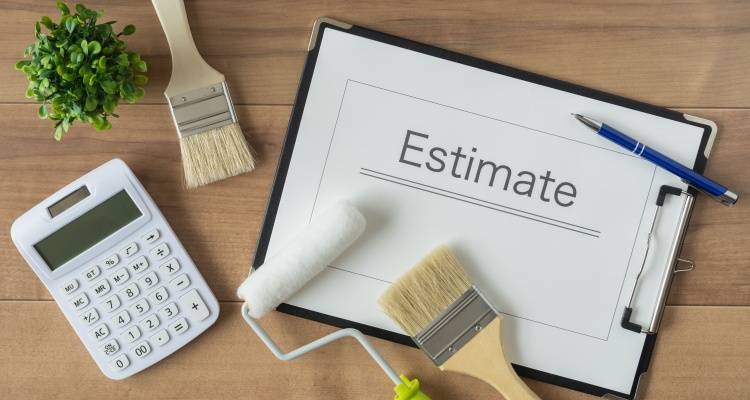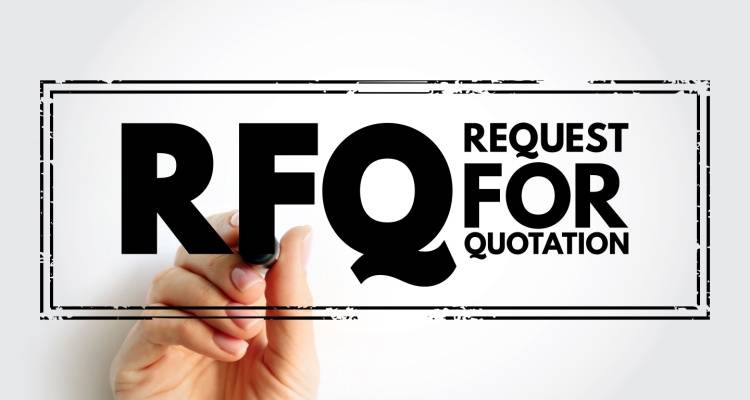What’s the Difference Between a Quote and Estimate?
The words “quote” and “estimate” may be used interchangeably during proposal periods, but their definitions are not to be mistaken. If it’s your first time having work done on your property, getting to grips with unfamiliar terminology can be a steep learning curve — but we’re here to make it easier to understand.

So, whether you are looking to get building work done on your home, spruce up your garden, or want to have a new kitchen fitted, knowing the key differences between quotes and estimates will help to inform you throughout the process, ensuring you’re clued-up from start to finish.
Let’s get started!
- A quote is an exact price.
- An estimate is an approximation.
- Quotes are legally binding, with exact figures, timelines, inclusions, and exclusions.
- Estimates are non-binding, based on assumptions, usually reflecting the final quote with between 10% and 20% leeway.
- Both quotes and estimates play important parts in the proposal process, with estimates informing the final quote.
Table of Contents
What Are the Main Differences Between a Quote and an Estimate?
Quotes are exact prices. They are agreed upon before work begins and are legally binding once signed, ensuring contractors cannot hike their costs during the job. They also include an itemised list to ensure all elements are outlined before any work begins.

Estimates are used to define a rough budget giving a ballpark figure based on assumptions, with a range of itemisation possibilities. They’re used during the early stages of a project while the scope is still being determined. They aren’t legally binding, and prices can change when they transition from the estimate to the final quote.
Let’s look at their key differences:
| Quote | Estimate |
|---|---|
| Fixed price | Approximate price/ballpark figure |
| Binding, contractual | Non-binding, informal |
| Defined scope | Assumptive scope |
| Agreed itemised list | Range of itemisation possibilities |
| Required before a project begins to ensure costs are known and agreed | Useful in a project's early stages to define budget |
Let’s look at the use of estimates and quotes in the example of a new kitchen installation:
- Discuss the intended project with the contractor (for example, a basic kitchen renovation to include new cabinets and counters).
- The contractor will go away and price up options for you based on your input, finding a range of materials and price ranges to choose from.
- A number of estimates will be given, with a price range for each, depending on the materials, finishes, and other factors — with approximate timelines based on assumptions.
- You will decide which option is best and confirm with the contractor.
- The contractor will then provide you with a quote once you’ve reviewed the estimates.
- The quote will include a fixed price, exact start and finish dates, and any inclusions and exclusions.
What Is a Quote?
A quote is an exact price. Quotes will contain an itemised list of supplies and activities that add up to your final figure — showing you exactly what is included in a trader’s service and what isn’t.
Quotes are legally binding, so once you’ve received a quote from a tradesperson, it is effectively seen as a legally binding contract. This is important to note as, unlike an estimate, quotes cannot change once they have been formally assigned, which helps to prevent traders from raising their prices unexpectedly and charging you more than originally agreed.
Tradespeople will give you a formal quote once the project scope has been determined and agreed upon between parties. This is usually the last stage in the preparation process before work begins on your project.
Once signed and agreed upon, a quote is a legally binding document that reflects the contractor's firm commitment.
What Is an Estimate?
An estimate is an approximation. It will contain approximate prices and ballpark figures to give you a rough idea of the expected costs for a given project.
Estimates are informal and non-binding, which means prices can change without consequence. Figures will commonly be used as “starting points” to price a job while the scope is still being determined between parties.

This being said, estimates are fairly accurate and give a range of costs. They will usually reflect the final quote with 10% to 20% of leeway. Contractors use estimating software to get accurate costs, which helps with this process.
Estimates are useful tools in early-stage project work to provide ballpark figures. While they aren’t legally binding, and prices can change, they are a useful starting point to give you a relatively clear idea of budgetary requirements, helping you to refine your project scope to fit your needs.
How to Calculate a Quote vs an Estimate
Depending on the project, your contractor will use different ways to draw up quotes and estimates. Here’s a closer look at the difference between quotes and estimates when it comes to how they’re calculated:
Calculating an Estimate
Starting with estimates, a contractor may simply have a “gut feeling” about a project’s expected price due to their experience and time in the industry and be able to offer an estimated figure to you on the spot.
Estimates can also be based on fact and not just on assumptive provisional figures.
For instance, a tradesperson can use base prices to calculate a full project cost. This can include set prices per square metre when laying flooring — but the variation will be in the size of the space, the complexity of the pattern (herringbone or parquet vs. standard slats), and the base cost of the materials.
This way, a contractor can provide you with an approximate figure for the entire project based on fact. This route will commonly give you the closest match between estimates and quotes, coming to within 10% to 20% of the final quote price.
A landscaping company can take the same approach. The cost of skip hire varies by capacity, but approximate values will crop up when the number of skips is unknown. This can result in a range of prices being listed on your estimate until the details are locked down.
Estimating software is also available, which can help provide accurate ballpark figures in a project's preliminary stages.
Calculating a Quote
Your contractor will calculate your formal quote based on your informal estimates. They can use their industry knowledge to inform this or can use quotation software.
Once materials/fixtures/fittings have been decided between the contractor and customer, the exact items will be listed with their current cost prices. For this reason, it’s important that quotes are acted on quickly to ensure the prices remain consistent.
The project scope will have been determined by the time a quote is calculated, so the contractor will be able to document the costs for labour, materials, subcontractors, and any overheads as required.
Inclusions and exclusions will be listed alongside an itemised breakdown of activities, and the terms and conditions will be outlined. If the contractor is VAT-registered, VAT will also be calculated and listed alongside their VAT registration number.
What Should You Include in an Estimate vs a Quote?
To help distinguish the difference between a quote and an estimate, let’s see what’s included on both documents — and what’s different.

Required on Quotes and Estimates
To begin with, the same general information will be required on both quotes and estimates:
- Client contact information
- Project address/exact location
- Named contact (to ensure consistency)
- Reference number (for internal purposes to distinguish clients from one another)
- Date of quote/estimate
- Project scope (itemised for quotes; approximations for estimates)
- Final total (exact figure for quote; ballpark for estimates)
- Terms and conditions
There will be some variances depending on your exact project.
Required on Quotes
Now, let’s take a look at what extra information might be required on quotes.
- Itemised breakdown of activities (to include any services and labour charges).
- Itemised breakdown of materials (including who is sourcing them, at what cost, and where from).
- Total fixed price for all activities, labour, and materials (firm and legally binding).
- VAT should be included, and VAT registration number (if the contactor is VAT-registered).
- A date showing how long the quote is valid for.
Your contractor may also choose to include additional information at this stage, such as certifications showing health and safety qualifications or licences to use certain equipment.
Required on Estimates
Lastly, here’s what may be included on estimates but not quotes.
- Range of prices (commonly used to show different finishes/fixtures/material costs depending on the client’s final choice).
- No itemisation/breakdown (this will be required later in the quote).
- A note that the prices are representative and based on approximate values, and can change, going up or down as the market fluctuates.
- A timeline of how long the estimate is valid (usually between 30 and 90 days).
Summary
Both quotes and estimates play important roles in projects, with informal approximate estimates informing your final legally binding quote.

Here’s a quick recap of the difference between a quote and an estimate:
- Quotes are legally binding exact prices, telling you precisely how much you will pay a contractor for their services.
- Estimates are informal ballpark figures based on assumptions and approximations.
- Contractors can use a range of methods to draw up estimates, from “gut feelings” from experience in the industry to estimating software and market research.
- Quotes will detail each aspect of the job, with an itemised breakdown outlining included labour, activities, materials and any other inclusions or exclusions.
- Before any work starts, ensure your quote is agreed between parties so you are completely clued up on what’s expected from both sides.
Now we know the difference between quotes and estimates, your home project can finally begin!
FAQs
Should an Estimate Include VAT?
It is formally required on quotes where the final figure is fixed and agreed upon, but having an indication on an estimate can help the customer understand there will be an extra 20% to pay on top of the final fee.
Alongside the VAT value, the contractor’s VAT registration number should be listed to prove their legitimacy.
What Is Included in an Estimate?
As estimates are approximations, they will contain ballpark figures to show a price representation for a given project. The estimate is usually valid for 30 to 90 days before it expires with the contractor.
Estimates are not legally binding, and the costs can change between the estimate and the quotation stage.
Is a Quote a Fixed Price?
Estimates can contain “fixed prices” for activities where the value is already known — skip hire, for example — but the approximation comes in when the contractor doesn’t necessarily know how many skips will be required and for what length of time, leading to the assumptions.
What’s the Difference Between a Quote and a Bid?
Bids are somewhat of a middle ground between quotes and estimates, containing more detail than an estimate, but aren’t legally binding and final like a quote.
Bids contain detailed information about timelines and project costs. They are typically seen when a large commercial company is vying for a contract with another large commercial company and are not commonly used between homeowners and contractors.
What Are Provisional Sums?
Sources
https://www.disputeresolutionombudsman.org/blogs/q-what-is-the-difference-between-and-estimate-and-a-quotation-and-why-is-it-important
https://tallysolutions.com/us/accounting/difference-between-estimate-quote-bid-proposal/
https://www.turtons.com/blog/what-is-a-provisional-sum








